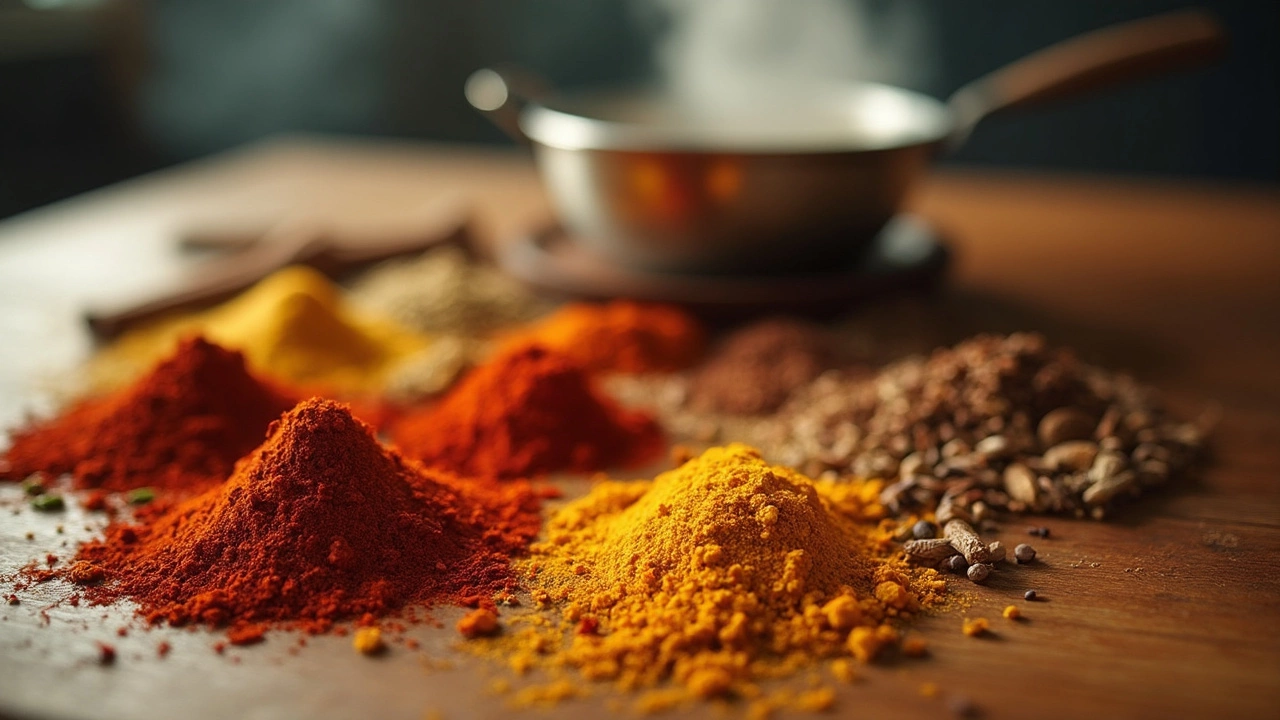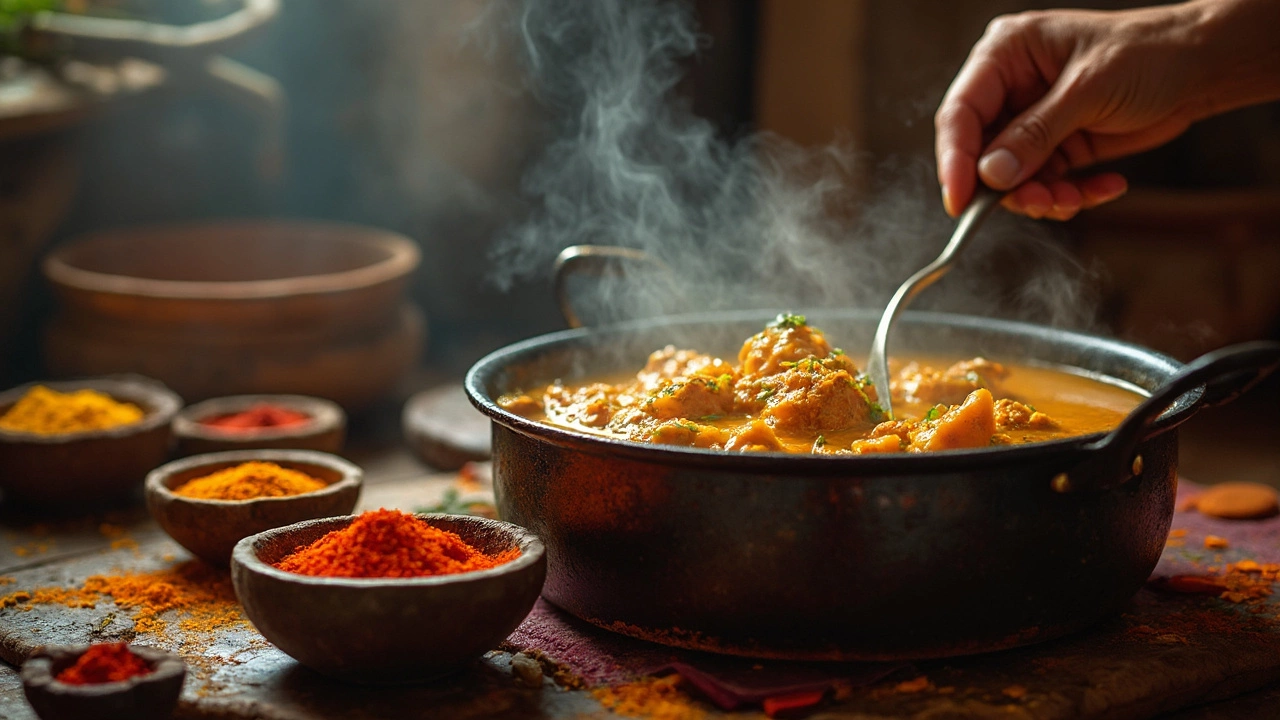11 Feb 2025
- 0 Comments
What makes a chicken curry sing with flavor? It's a question that many home cooks ponder as they stir their simmering pots. The magic lies in understanding the components that add depth to this beloved dish. First things first, you’ve gotta talk about spices. These tiny flavor powerhouses are the backbone of any curry. Whether it's the warmth of cumin or the zing of coriander, choosing the right mix is crucial.
Next, it's all about technique—slow cooking is your best friend here. It allows those flavors to really meld together, creating that rich, complex taste that everyone seeks. Ever notice how your curry tastes better the next day? That's the spices continuing to work their magic.
Spice Selection
Picking the right spices is where the magic of a great chicken curry really starts. It's all about layering flavors that coalesce into something greater than the sum of its parts. You don't need a spice cabinet that mimics a mini-mart, just a few key players that pack a punch.
Cumin is the unsung hero here—earthy and warm, it forms the foundation upon which other spices build. Pair that with coriander for a fresh, slightly citrusy undertone. These two partners in crime often work together in the flavorful dance that is curry.
Tumeric is another cornerstone, with its vibrant color and mild peppery taste; it invokes those traditional curry roots we all know and love. Just a pinch can do wonders. Oh, and don’t forget about garam masala. This mix of spices like cardamom, nutmeg, and cloves adds layers of complexity, rich in aroma and taste.
Measuring it Right
Balance is key, so use these spices wisely. Too much of one thing can overpower all the others, leaving you with an uninviting bite. Start small, and you can always add more as the flavors develop. A basic rule of thumb? You’re looking at about a teaspoon of each, adjusting to taste as you go along.
Grinding Your Own
If you really want to elevate your dish, think about grinding your own spices. Freshly ground spices are like fresh tunes—they resonate more. Or, if you’re short on time, you can toast whole spices lightly on a pan to release those intense oils and aromas before grinding them down.
Crafting the perfect chicken curry is a labor of love and attention. Taking the time to choose and prepare the right spices can transform your dish from nice to ‘wow, what's in this?’ And honestly, isn’t that the goal of any home-cooked meal?
Cooking Techniques
When it comes to making a spectacular chicken curry, understanding the right cooking techniques is key. These methods transform basic ingredients into a full-flavored masterpiece. Let's see how!
Slow Cooking
One of the top techniques for achieving that deep flavor is slow cooking. This isn't just a buzzword; it really lets the spices and chicken blend together beautifully. Using a slow cooker or simmering on low heat is your best bet.
The reason slow cooking works like magic is simple: it gives time for the collagen in the chicken to break down, which not only tenderizes the meat but also enriches the sauce with a delightful texture.
Browning the Chicken
Always start by browning the chicken pieces in oil or ghee. This step adds a layer of flavor right from the start by caramelizing the surface. Ghee, a type of clarified butter, is often used in traditional recipes and imparts a nutty richness to the dish.
Layering Ingredients
Did you know the sequence of adding ingredients affects the final taste? Begin with onions, ginger, and garlic, as these form the flavor base. Then, slowly incorporate the spices to release their essential oils before adding the chicken. This layering technique ensures that every element plays its part in flavor development.
Lid On or Off?
Leaving the lid on while simmering keeps the moisture in, making sure your curry doesn't dry out. However, if you feel it's too watery, removing the lid to let some liquid evaporate can thicken the curry without needing extra thickening agents.
Sometimes, adding a cup of coconut milk or yogurt towards the end can add creaminess, especially if you’re looking for a touch of richness.
Remember, practice makes perfect! Experiment with these techniques, and before long, your curry will taste like it took hours of labor, even if you spent a short time on it.

Balancing Flavor
Creating a chicken curry that's both rich and balanced isn't just about tossing everything into a pot and hoping for the best. It's a bit like being a flavor detective, figuring out what each ingredient adds to the mix and how you can make them all sing in harmony.
The first step? Get friendly with salt. It might seem basic, but salt is a powerful tool for enhancing the taste of all the other ingredients. Too little, and your curry will taste flat. Too much, and it's overpowering. The trick is to add a pinch at a time, tasting as you go.
Now, let's talk acidity. Ever notice how a squeeze of lime or a dash of vinegar can make flavors pop? Acid balances out the heat and richness, giving your curry a refreshing kick. You can use ingredients like tomatoes or yogurt for that tangy touch.
Adding Sweetness
Sweetness can be a game-changer in a curry recipe. Consider caramelizing onions at the start of your cook—they add a natural sweetness that complements the spices perfectly. For a little extra, try adding a bit of sugar or honey, but always in moderation. It's all about that sweet-savory contrast.
Layering Flavors
This is where the real depth comes in. Think of building a curry like painting a picture. You start with a base layer of foundational spices like cumin and coriander. Then, add layers of flavor with garlic, ginger, and chili. Each brings something unique to the table, creating a more complex final dish.
Finally, don't forget the creamy element. Coconut milk or cream can soften sharp flavors and add richness without weighing everything down. Remember, balance is key, so adjust quantities based on your taste preferences.
Get playful with these elements, taste and tweak your curry along the way, and you'll soon become a master at achieving that perfect balance of flavors in your favorite curry dish.
Traditional Tips
When it comes to cooking a chicken curry with authentic depth, borrowing a few tricks from traditional methods can be a game-changer. These age-old techniques have been passed down through generations for a reason—they work!
Use Fresh Ingredients
The first tip is quite simple but powerful. Always use fresh ingredients. Fresher spices have a more intense flavor, which builds a spicier and more fragrant base for your curry. Toast whole spices before grinding to maximize flavor; it brings out essential oils and adds a beautiful aroma.
Layer Your Spices
When cooking your curry recipe, add spices in layers. Start with the whole spices in the hot oil before adding your onions and garlic. Then, mix in powdered spices as you cook your mixture. Doing so ensures a rich flavor coating each ingredient evenly.
Don’t Skimp on Patience
This might sound odd, but patience is a key ingredient. Traditional recipes often call for slow cooking. It allows all ingredients to combine their flavors harmoniously. Slow cooking will do wonders for your chicken curry. Try simmering it on low for at least an hour, occasionally stirring.
Table of Traditional Spice Combos
| Type of Curry | Essential Spices |
|---|---|
| South Indian | Mustard seeds, curry leaves, tamarind |
| North Indian | Cumin, cinnamon, garam masala |
| Thai Curry | Lemongrass, galangal, lime leaves |
These tips aren't just about improving taste. They connect you to a culinary legacy, making the cooking experience even more rewarding.
